2.1 Many of today's environmental challenges have a systemic character
European environmental policy measures have proven to be particularly effective when it comes to tackling local, regional and continental environmental pressures. However, some of the environmental and climate challenges we are facing today differ from those we have successfully addressed over the past 40 years: they are both systemic and cumulative in their nature and depend not only on our actions in Europe, but also on their global context.
Many of today's environmental challenges are characterised by their complexity (i.e. they have multiple causes and feature many interdependencies between their underlying drivers and associated impacts). They are difficult to delineate or define clearly as they pervade different parts of the environment and society in various ways. Thus, they are often perceived differently by different groups in society and at different geographical scales.
Three systemic characteristics that are common to many of today's environmental challenges are of particular importance here (Figure 2.1).
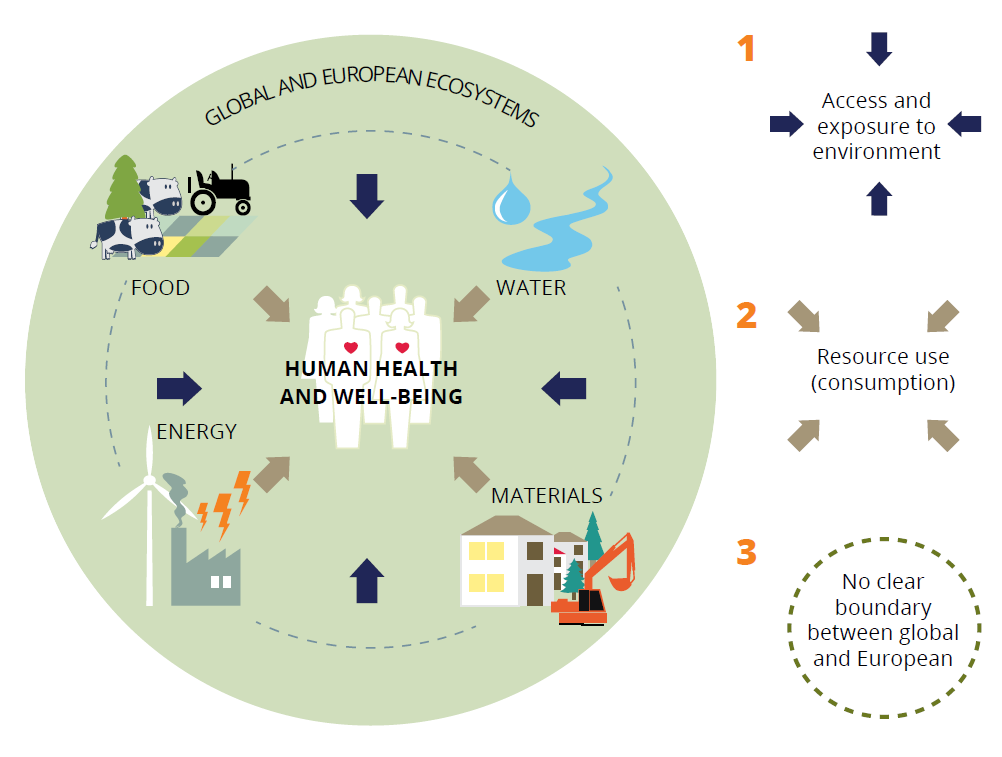
First, they directly and indirectly affect exposure to environmental factors that affect human health and well-being, as well as our prosperity and standard of living. Such factors include harmful substances in our environment; severe weather events such as floods and droughts; and (in extreme cases) the potential for entire ecosystems to become uninhabitable. All of these factors may limit our future access to basic environmental goods, such as clean air, clean water and fertile soils.
Second, they are intrinsically linked to our consumption and resource use patterns. Major resource use categories can be distinguished in this regard: food, water, energy and materials (the latter of which also include construction materials, metals and minerals, fibre, wood, chemicals and plastics), as well as land. Using these resources is essential for human well-being. At the same time, extracting and using resources — especially when unchecked — adversely alters the ecosystems that provide them.
The resources within these categories are also heavily interlinked. For example, substituting fossil fuel use with bioenergy crops may help address energy concerns, but it has been linked to deforestation and land conversions at the expense of natural areas (UNEP, 2012a). This has implications for the area available for food crops. Because global food markets are linked, it also has implications for food prices. As a result, environmental degradation has severe implications for the current and long-term security of access to key resources.
Third, their evolution depends on European trends and global megatrends, including those related to demographics, economic growth, trade patterns, technological progress, and international cooperation. These long-term patterns of change that unfold at a global scale over decades are increasingly difficult to disentangle (Box 2.1). This interconnected global context makes it more difficult for countries to resolve environmental problems unilaterally. Even large groups of countries acting together (such as the EU) cannot resolve these problems on their own.
The case of climate change illustrates this well: emissions contribute to global atmospheric concentrations, producing impacts far from the source — and potentially far into the future. Similarly, although emissions of ozone precursor gases in Europe have decreased significantly in recent decades, measured ground-level ozone concentrations have reduced only marginally or have even increased due to long-range transport of pollutants from outside Europe (EEA, 2014r).
2.2 Global megatrends affect the prospects for the European environment
Globalisation and the unfolding of global trends imply that environmental conditions and policies in Europe cannot be fully understood — or properly managed — in isolation from global dynamics. Global megatrends will alter future European consumption patterns and influence the European environment and climate. By anticipating these developments Europe can harvest the opportunities they create to reach environmental targets and move towards the objectives stated in the 7th Environment Action Programme.
Such megatrends relate to demographics, economic growth, patterns of production and trade, technological progress, the degradation of ecosystems, and climate change (Figure 2.2 and Box 2.1).
Source: EEA.
Diverging global population trends: The world population has doubled to 7 billion since the 1960s and is projected to continue growing, although in advanced economies populations are ageing and in some cases reducing in size. Conversely, populations in the least developed countries are expanding rapidly.
Towards a more urban world: Today, about half of the global population lives in urban areas, and this share is projected to increase to two thirds by 2050. With adequate investment this continued urbanisation can boost innovative solutions to environmental problems, but may also increase resource use and pollution.
Changing disease burdens and risks of pandemics: The risk of exposure to new, emerging and re-emerging diseases, and new pandemics is linked to poverty and grows with climate change and the increasing mobility of people and goods.
Accelerating technological change: New technologies are radically transforming the world, particularly in the fields of nano-, bio-, information and communication technologies. This provides opportunities to reduce humanity's environmental impacts and increase resource security but also brings risks and uncertainties.
Continued economic growth?: While the continuing impact of the recent economic recession still dampens economic optimism in Europe, most outlook studies foresee continued economic expansion globally in the coming decades — with accelerating consumption and resource use, particularly in Asia and Latin America.
An increasingly multipolar world: In the past, a relatively small number of countries have dominated global production and consumption. Today, a significant rebalancing of economic power is under way, as Asian countries in particular are coming to the fore, with impacts on global interdependence and trade.
Intensified global competition for resources: As they grow, economies tend to use more resources, both renewable biological resources and non-renewable stocks of minerals, metals and fossil fuels. Industrial developments and changing consumption patterns all contribute to this increase in demand.
Growing pressures on ecosystems: Driven by global population growth and associated food and energy needs, as well as by evolving consumption patterns, the loss of global biodiversity and the degradation of natural ecosystems is set to continue — affecting most severely poor people in developing countries.
Increasingly severe consequences of climate change: Warming of the climate system is unequivocal, and since the 1950s, many of the observed changes are unprecedented over decades to millennia. As climate change unfolds, severe impacts are anticipated for both ecosystems and human societies (including food security, drought frequency and extreme weather).
Increasing environmental pollution: Across the world, ecosystems are today exposed to critical levels of pollution in increasingly complex mixtures. Human activities, global population growth and changing consumption patterns are the key drivers behind this growing environmental burden.
Diversifying approaches to governance: A mismatch between the increasingly long-term global challenges facing society and the more limited powers of governments is creating demand for additional governance approaches, with a greater role for business and civil society. These changes are necessary but raise concerns about coordination, effectiveness and accountability.
By 2050, the global population is expected to exceed 9 billion, according to projections by the United Nations (UN, 2013). Today, the global population is 7 billion, and in 1950 it stood at less than 3 billion. Since 1900, materials use has increased tenfold (Krausmann et al., 2009), and may double again by 2030 (SERI, 2013). World demand for energy and water are both projected to rise by between 30% and 40% over the next 20 years (see, for example, IEA, 2013, or The 2030 Water Resource Group, 2009).
Similarly, total demand for food, feed, and fibre is projected to grow by about 60% between now and 2050 (FAO, 2012), while the area of arable land per person may decrease by 1.5% per year if no major policy changes are initiated (FAO, 2009).
Human appropriation of net primary production (i.e. the share of vegetation growth that is directly or indirectly used by humans) has steadily increased with population growth. Human-induced land-use changes, such as the conversion of forest to cropland or infrastructure (including mining), account for a major part of the annual appropriation of biomass in Africa, the Middle East, eastern Europe, central Asia and Russia. In contrast, crops or timber account for most of the appropriation in western industrial countries and Asia.
Seen individually, each of the above global trends is striking in its own right. Taken together they look set to have a profound impact on the state of the environment and the availability of key resources globally.
Growing concerns about food, water and energy security have fuelled transnational land acquisitions in the last 5–10 years, primarily in developing countries. Between 2005 and 2009 alone, global foreign land acquisitions totalled some 470 000 km2, which is comparable to the size of Spain. In some countries (particularly in Africa) large parts of the agricultural area have been sold to foreign investors, mostly from Europe, North America, China and the Middle East (Map 2.1).
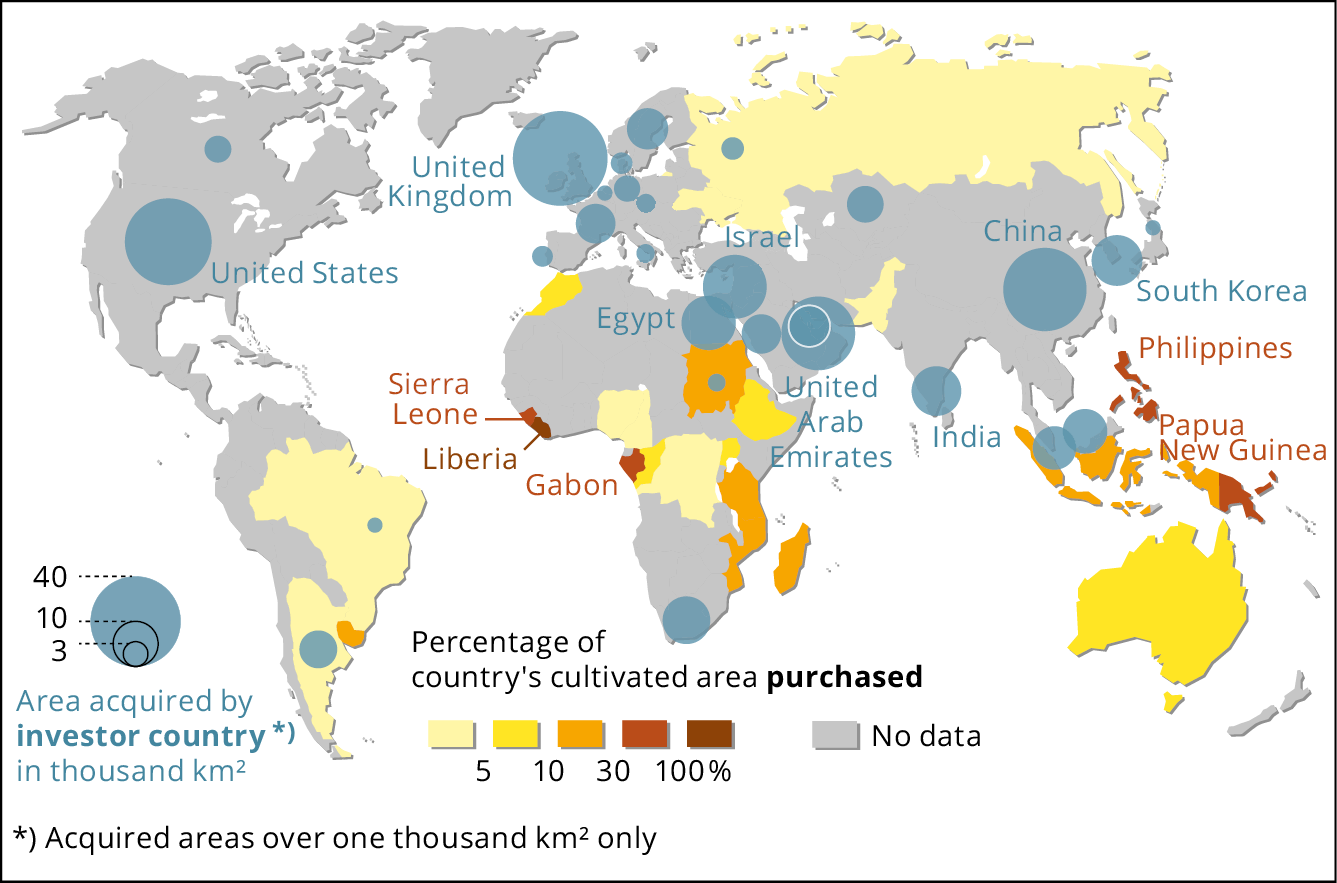
Source: Adapted from Rulli et al., 2013.
Combined with population growth and climate change, increasing demand for food is also expected to create significant threats to the availability of freshwater (Murray et al., 2012). Even if we continue to use water more efficiently, the absolute agricultural intensification needed to meet the world's growing food and feed demand — due to population growth and changing diets — could lead to severe water stress in many world regions (Pfister et al., 2011).
The escalating resource scarcities in other parts of the world that could result from these trends have far-reaching implications for Europe. Most obviously, increased competition raises concerns about security of access to supplies of key resources. Prices of major resource categories have risen in recent years after several decades when they seemed to be in long-term decline. Higher prices reduce the spending power of all consumers but the effects are often felt most keenly by the poorest(4).
These developments have both direct and indirect implications for the outlook on resource security. Europe's long-term supply of — and access to — food, energy, water and material resources depends not only on improving resource efficiency and ensuring resilient ecosystems in Europe but also on global dynamics beyond Europe's control. European efforts to reduce environmental pressures are increasingly offset by accelerating trends in other parts of the world.
2.3 European consumption and production patterns impact both the European and global environment
Globalisation not only means that global trends have implications for society, the economy, and the environment in Europe. It also means that consumption and production patterns in a country or region contribute to environmental pressures in other parts of the world.
The environmental consequences of European consumption and production can be understood from two different perspectives. Firstly, a 'production' perspective broadly looks at pressures exerted by resource use, emissions and ecosystem degradation within the European territory. Secondly, a 'consumption' perspective focuses on environmental pressures of the resources used or emissions embedded in products and services consumed in Europe — both those produced in Europe and those imported.
A considerable share of the environmental pressures associated with consumption in the EU is felt outside the EU's territory. Depending on the type of pressure, between 24% and 56% of the associated total footprint occurs outside Europe (EEA, 2014f). To illustrate this: of the land footprint associated with products consumed within the EU, on average 56% is estimated to lie outside the EU territory. The share of the environmental footprint of EU demand that is exerted outside EU borders has increased during the past decade for land, water, and material use, as well as for air emissions (Figure 2.3).
Note: The footprint relates to total final demand, comprising household consumption, government consumption and capital investment.
Source: EEA, 2014f; based on JRC/IPTS analysis of World Input-Output Database (WIOD), EC, 2012e.
Estimates show that the total material requirement and emissions caused by the three European consumption areas with the highest associated environmental pressures — i.e. food, mobility, and housing (built environment) — showed no significant reductions between 2000 and 2007 (EEA, 2014r). However, when looking from a production perspective, in many economic sectors there has been a reduction in material demand and emissions, or a decoupling between growth and emissions. This divergence between production perspective trends and consumption perspective trends is common.
In the case of carbon dioxide, EU consumption emissions due to goods consumed in Europe are higher than production emissions of goods produced in Europe, with the largest difference occurring in 2008 where consumption emissions were about a third higher than production emissions (Figure 2.4). Over the period 1995–2010, EU production emissions show a decreasing emission trend whereas consumption emissions after an initial increase were slightly higher in 2010 than in 1995 (Gandy et al., 2014). Global emissions have risen over the same time period and European consumption and production emissions have decreased as a fraction of the global CO2 emissions embedded in goods from 20% to 17% and from 15% to 12%, respectively. However, it should be borne in mind that consumption-based estimates are subject to greater data uncertainty and shorter time series, as well as difficulties in defining system boundaries (EEA, 2013g).
Note: Emissions embedded in goods (products and services) excludes residential emissions as well as emissions by private road transport. Private road transport is estimated to contribute 50% of total road emissions.
Source: Gandy et al., 2014.
The lack of standardisation makes it more difficult to use consumption based estimates in policymaking. International environmental conventions (such as the United Nations Framework Convention on Climate Change, UNFCCC) are based on the 'territorial' perspective when accounting for a country's emissions and mitigation efforts, referring only to areas that are under a country's sovereignty and where a country can implement and enforce legislation and policies. The territorial perspective includes all emissions taking place on the country's territory, regardless of the economic actors responsible for them.
Although a consumption perspective on emissions is not addressed in international conventions, it is embedded in the EU's policy framework on sustainable production and consumption, for example via product standards and life-cycle approaches. When it comes to climate change in particular, carbon emissions need to be considered globally as they affect the planet's climate system no matter where they are released. Thus, major efforts at combatting climate change continue to focus on reaching a global agreement on emission reductions, covering all sources of emissions, and where all countries contribute their fair share.
There is a similar divergence between production pressures and consumption pressures when it comes to the use of water resources. Here the divergence can be seen by comparing water use within European territory with 'virtual water' trade (embedded in water-intensive products, such as agricultural commodities). The 'virtual water' concept captures the volume of freshwater used to produce goods that are traded internationally. It is estimated that the number of trade connections and the volume of water associated with global food trade more than doubled in the period from 1986 to 2007 (Dalin et al., 2012).
The 'virtual water' concept has its limitations for use in policymaking (EEA, 2012h). Still, for most European countries and regions such consumption based estimates of water use exceed territory based estimates (Lenzen et al., 2013). However, it is worth noting that some parts of Europe are net exporters of virtual water. For example, the Spanish region of Andalusia uses large amounts of water in its exports of potatoes, vegetables and citrus fruits, while importing cereals and arable crops with lower water requirements (EEA, 2012h).
At a more aggregate level, the difference between production pressures and consumption pressures can be illustrated using the concept of 'footprints' (e.g. Tukker et al., 2014; WWF, 2014). The 'ecological footprint', for example, provides an indication of the combined use of land, renewable material resources and fossil fuels. It shows that for most European countries this currently exceeds their available biologically productive area or 'biocapacity'. Available estimates suggest that total global consumption exceeds the planet's regenerative capacity by more than 50% (WWF, 2014).
These different ways of looking at the difference between production related pressures and consumption related pressures all show that European consumption habits are affecting the global environment. This raises questions as to whether European consumption patterns would be sustainable if globally adopted — especially given the global environmental changes already occurring.
2.4 Human activities affect vital ecosystem dynamics at multiple scales
Human activities across the globe are already significantly changing major bio-geochemical cycles on Earth. The changes are sufficiently large to alter the normal functioning of these cycles. Such bio-geochemical cycles involve the planetary scale pathways for the transport and transformation of matter within the earth's biosphere, hydrosphere, lithosphere, and atmosphere. They regulate the transport of carbon, nitrogen, phosphorus, sulphur, and water, all of which are of fundamental importance for the planet's ecosystems (Bolin and Cook, 1983).
Simply put, these dynamics can be summarised by two types of human-induced global environmental changes, which both directly and indirectly impact the state of the environment in Europe (Turner II et al., 1990; Rockström et al., 2009a):
- systemic changes (systemic processes at a global scale), i.e. changes that manifest at continental or global scale with direct impact on environmental systems (such as climate change or ocean acidification),
- cumulative changes (aggregated processes from local or regional scale), i.e. changes that primarily occur on a local scale but are so widespread that they amount to a global phenomenon (such as soil degradation, or water scarcity).
The resulting human influence on global cycles has now reached unprecedented levels in the history of the planet, and researchers argue that we have recently entered a new geological epoch: the Anthropocene (Crutzen, 2002). During the past three centuries, as human population increased more than tenfold, an estimated 30–50% of the global land surface has been transformed by human action.
The corresponding numbers — often cited to illustrate the impact on bio-geochemical cycles — are staggering. For example:
- use of carbon based fossil fuels has increased by a factor of 12 over the 20th century, and concentrations of several greenhouse gases have substantially increased in the atmosphere, i.e. carbon dioxide (CO2) by more than 30% and methane (CH4) by more than 100%;
- more nitrogen is now fixed synthetically and applied as fertilisers in agriculture than fixed naturally in all terrestrial ecosystems, and nitrous oxide emissions from fossil-fuel and biomass combustion is larger than the inputs from natural sources;
- global phosphorus flows to the biosphere have tripled compared to pre-industrial levels, due to the growth in fertiliser use and livestock production (MacDonald et al., 2011);
- today, sulphur dioxide (SO2) emissions from the burning of coal and oil around the world are at least double the amount of all natural emissions (which occur mainly as marine dimethyl-sulphide from the oceans);
- more than half of all accessible freshwater is used by mankind globally (mostly for agricultural production), and underground water resources are being depleted rapidly in many areas.
Thus, at a global scale we are generating more pollution and waste, causing increasing pressure on the planet's ecosystems. The scientific community is in agreement that we are contributing to global warming, and it highlights the increasing risk of water stress and water scarcity. Despite some positive developments, global habitat loss, biodiversity loss and environmental degradation have risen to unprecedented levels. Nearly two thirds of the world's ecosystems have been assessed as being in decline (MA, 2005).
Human exposure to these pressures and the resulting impacts are unevenly distributed, with poorer areas and societal groups often being much more affected than others. In its most recent assessment, the Intergovernmental Panel on Climate Change (IPCC, 2014b) suggests that climate change will exacerbate poverty in developing countries and amplify risks. This is a particular concern for those living in poor-quality housing and lacking basic infrastructure, as low-income groups rely disproportionately on the sustainability of local ecosystem services. Global environmental change is thus likely to enhance social inequities, with possible knock-on effects for migration and security.
The associated risks also extend to high-income countries. The Organisation for Economic Cooperation and Development has warned that the continued degradation and erosion of natural capital could endanger two centuries of rising living standards (OECD, 2012).
2.5 Excessive use of natural resources jeopardises humanity's safe operating space
It has been argued that enough is now known about the functioning of the earth's systems to justify the delineation of boundaries at planetary scale (Rockström et al., 2009a). Such planetary boundaries are human-determined levels that are a 'safe' distance from dangerous thresholds beyond which adverse environmental changes become irreversible, putting at risk ecosystem resilience and threatening human livelihoods (Figure 2.5).
Source: Adapted from Rockström et al., 2009b.
One planetary boundary of this sort has already been outlined by researchers who warn of the risks involved in climate change. In policy terms, these warnings have been translated into the 2 °C threshold: global mean temperatures must not increase by more than 2 °C above pre-industrial levels in order to avoid irreversible changes to the global climate.
Similarly, for ocean acidification, a bio-physical threshold might be defined in relation to the level of aragonite saturation in surface waters (which needs to be maintained at 80% or higher of the average global pre-industrial surface seawater) to ensure that coral reefs and associated ecosystems are not seriously impacted.
The International Resource Panel established by UNEP has argued that the overall conversion of forest or other types of land to cropland should not exceed 1 640 million hectares at the global level (UNEP, 2014a). Cropland currently already comprises about 1 500 million hectares, equal to around 10% of the world land area. It is worth noting, that under business-as-usual conditions, a further expansion of between 120 to 500 million hectares by 2050 is projected by the same assessment (UNEP, 2014a).
However, for other global change processes a 'safe operating space' may be more difficult to define, as thresholds may not exist or the thresholds may differ between different regional or even local ecosystems. In some cases, this may be because of scientific uncertainty about what the bio-physical thresholds or tipping points for different processes are and how they relate to each other. In other cases, the consequences of passing thresholds is unclear or we may not even be aware that we are approaching them.
Despite uncertainty, there is evidence that both planetary and regional boundaries for some areas have already been transgressed, including for biodiversity loss, climate change and the nitrogen cycle (Rockström et al., 2009a). In parts of the world, ecological limits for water stress, soil erosion or deforestation have been transgressed at local or regional scale.
This has both global and regional implications. For example, many regional seas across the globe suffer from oxygen depletion (hypoxia) due to excess nutrient discharges, which leads to a collapse of fish stocks. Europe is already suffering from this problem. The Baltic Sea — as a semi-enclosed regional sea with low salinity — is now considered the largest human-induced hypoxic area in the world (Carstensen et al., 2014).
When reflecting on whether and how ecological limits might be reflected in environmental policy objectives at European and national level, it is also important to consider the regional specifics. An understanding of concepts such as planetary boundaries can provide a meaningful starting point for discussing the role of ecological limits and policy options at levels lower than the global scale. However, defining these is not straightforward and will depend greatly on regional and local specifics (Box 2.2).
There is an on-going academic debate about how best to define terms such as 'planetary boundaries' or the related concept of a 'safe operating space' (Rockström et al., 2009a). Complementary concepts and discussions can be found in earlier research on 'carrying capacity' (Daily and Ehrlich, 1992); 'limits to growth' (Meadows et al., 1972); 'critical loads' and 'critical levels' (UNECE, 1979); and 'safe minimum standards' (Ciriacy-Wantrup, 1952). As far back as the 18th century there were reflections on how to ensure sustainable forestry (von Carlowitz, 1713).
The increased understanding of ecological limits developed during recent decades opens up questions about how a safe operating space can be translated into a policy context. The primary aim of such research has not necessarily been to support policymaking directly. However, this research may lend itself to reflections on how best to develop environmental targets and indicators to achieve the goal of 'living well, within the limits of our planet'. When designing policies and indicators for this purpose, three problems must be overcome:
- Knowledge gaps: There remain both 'known unknowns' and 'unknown unknowns', as regards environmental thresholds at both the European and global level — and the consequences of exceeding these. In addition, thresholds for non-linear processes are difficult to define at all.
- Policy gaps: Even where we do have knowledge about global systems, policies might fall short of what is currently known to be needed to stay within environmental constraints.
- Implementation gaps: This is the gap between the plans made and the results delivered. For example, plans may be frustrated by incompatibilities between policies in different sectors.
Source: Based on Hoff et al., 2014.
Notes
(4) The World Bank, 2008, suggests that the food crisis in 2008 increased the number of poor globally by 100 million, with long-term consequences for health and education. Oil price rises compounded this effect. Food prices subsequently spiked to similar levels in 2011 and 2012 (World Bank, 2013).
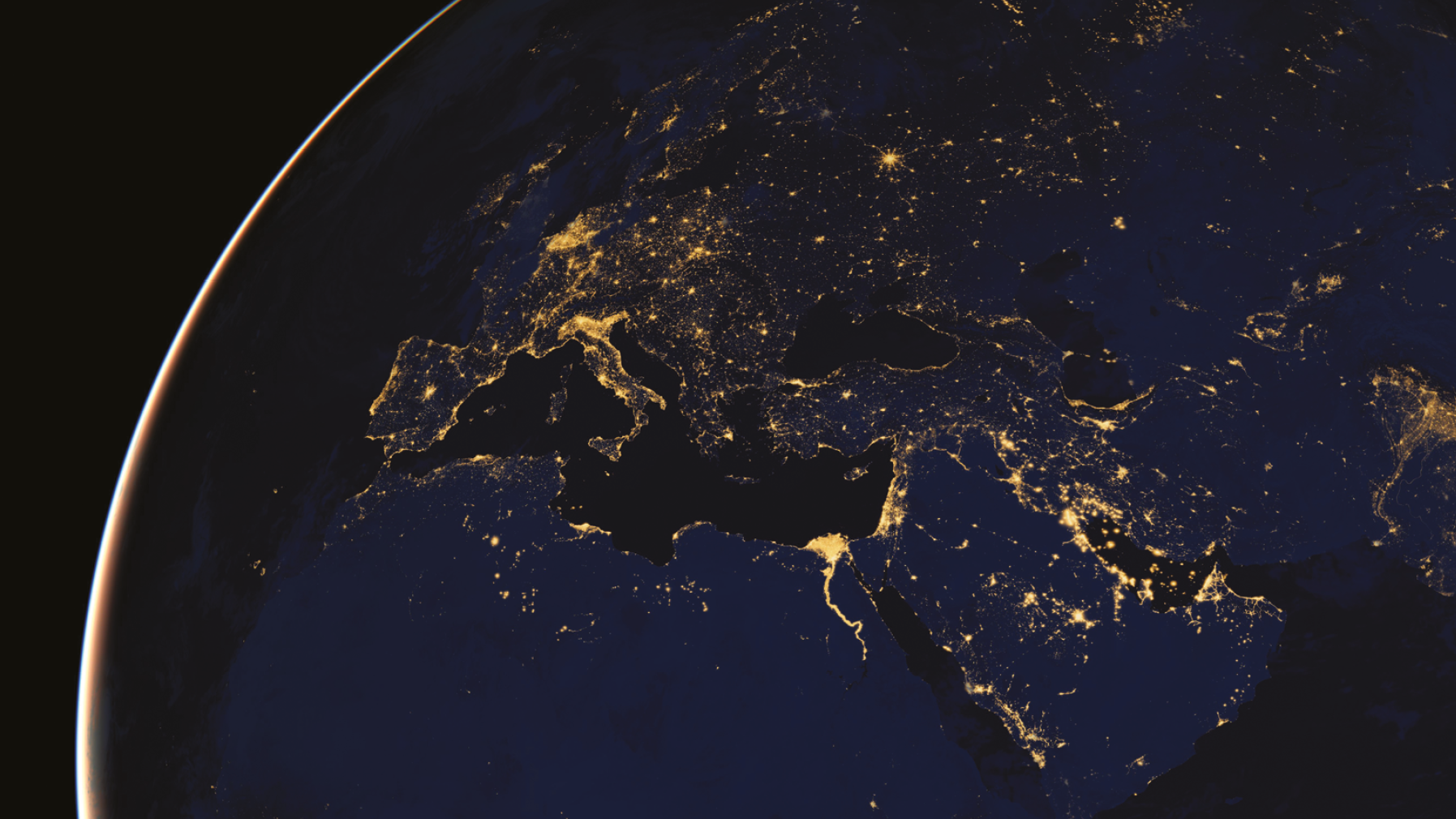

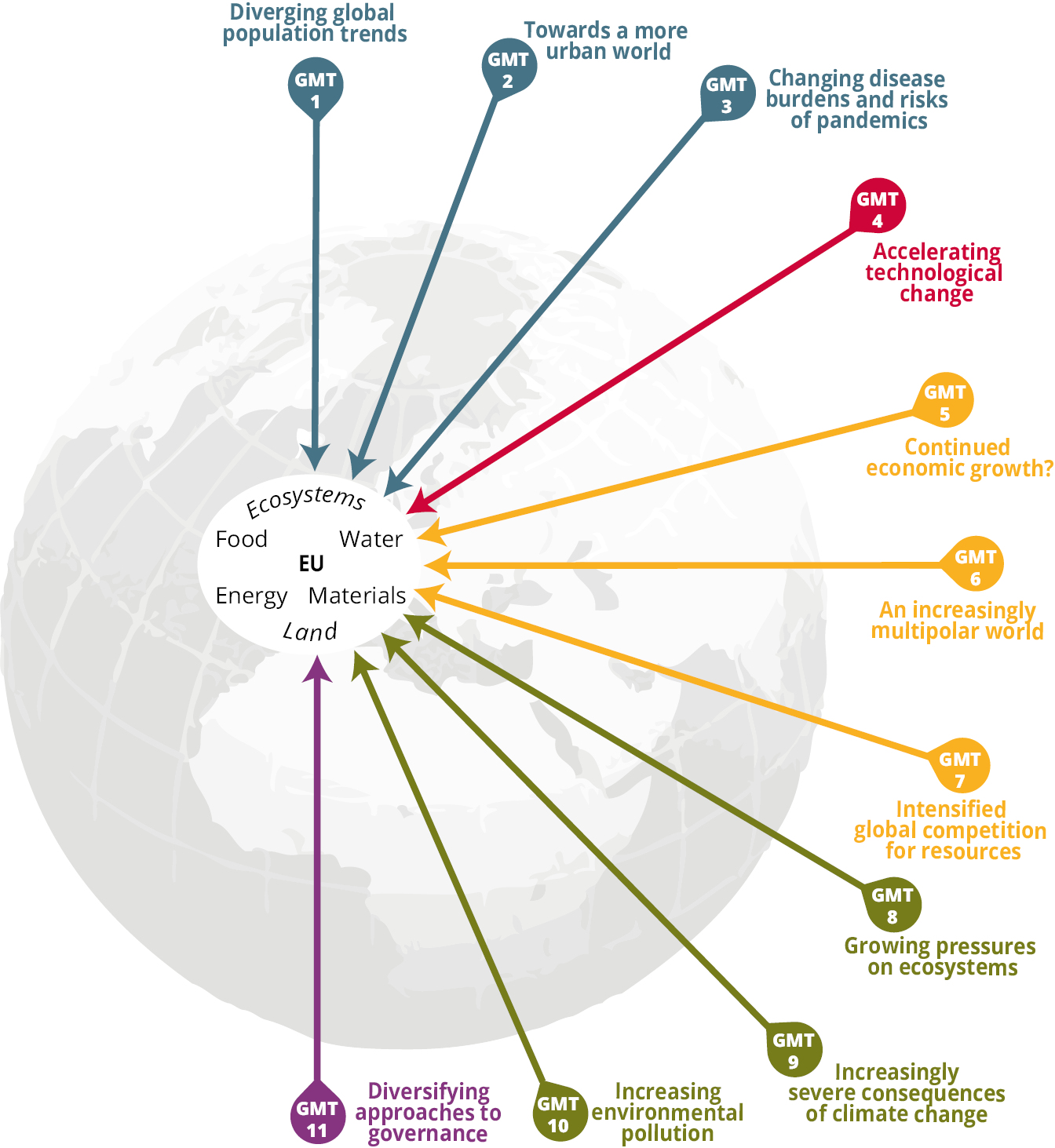

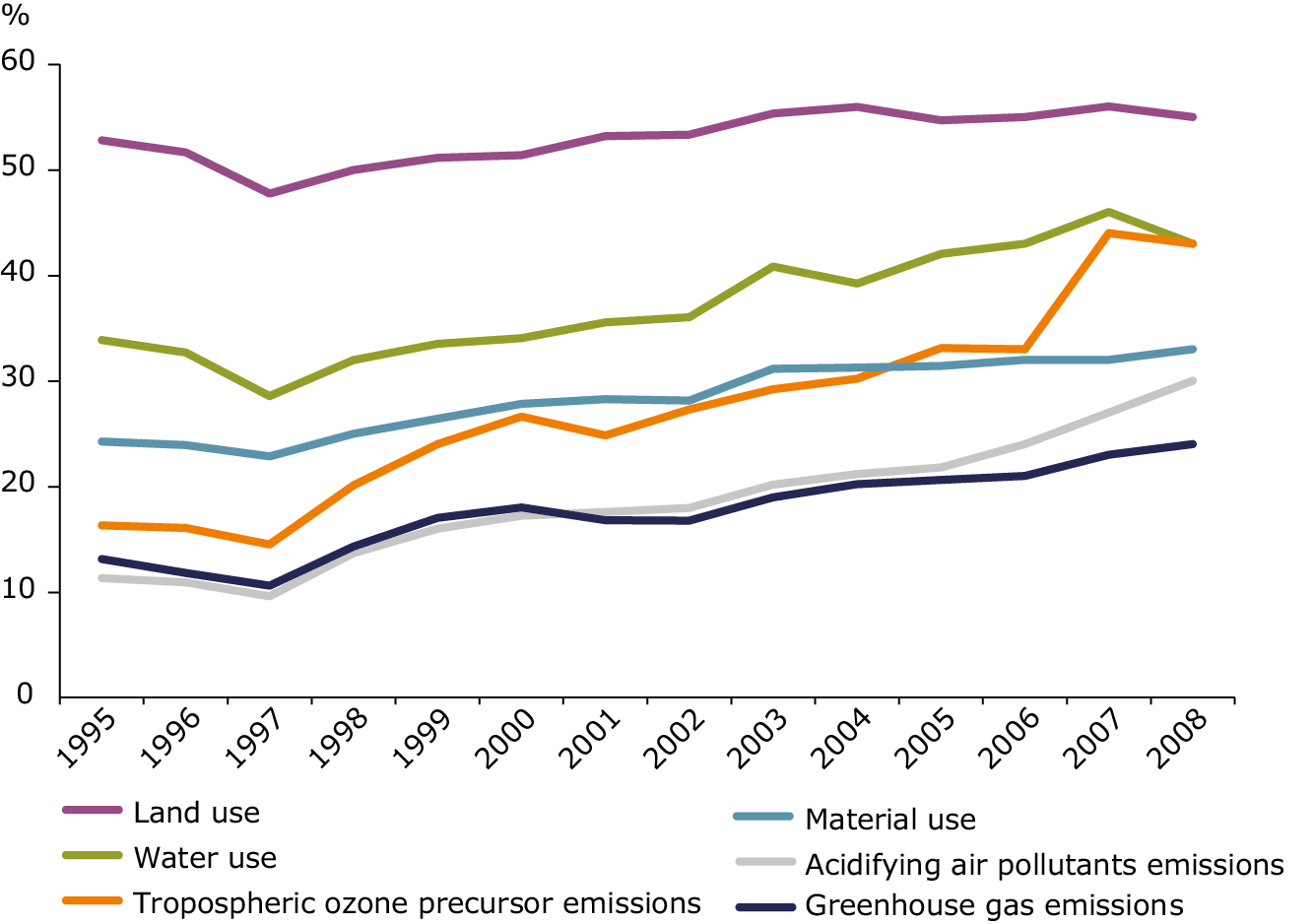
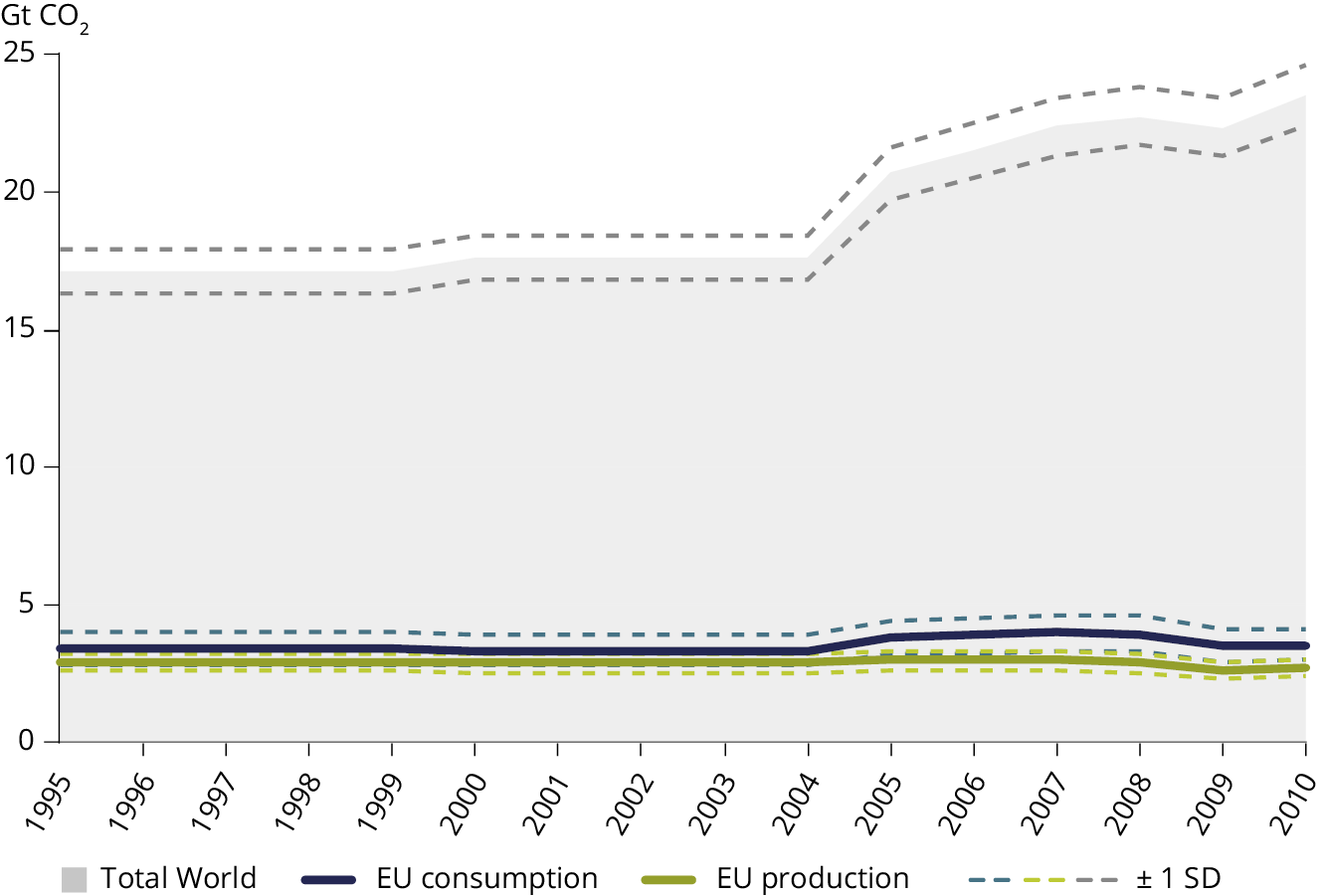
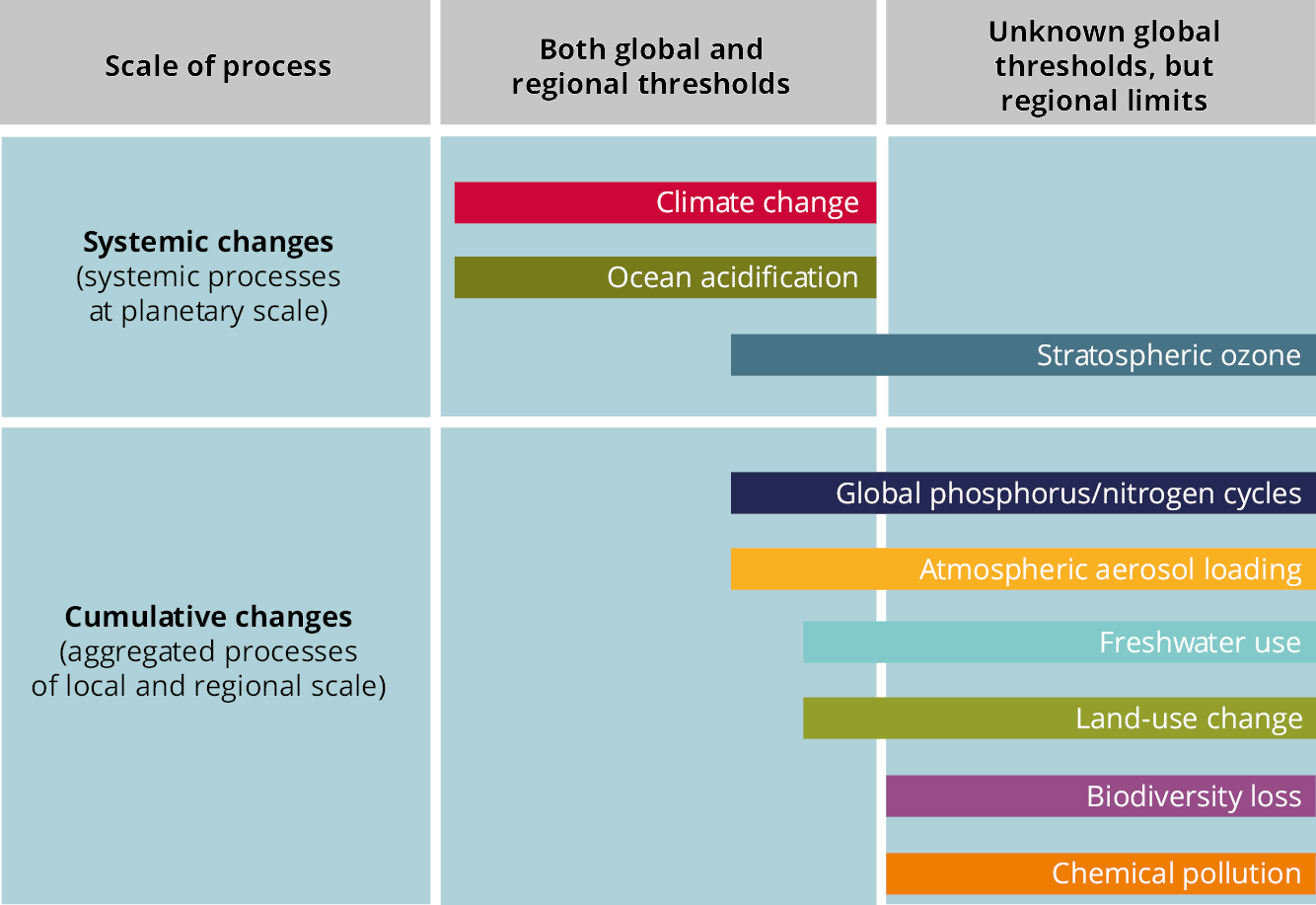
Document Actions
Share with others